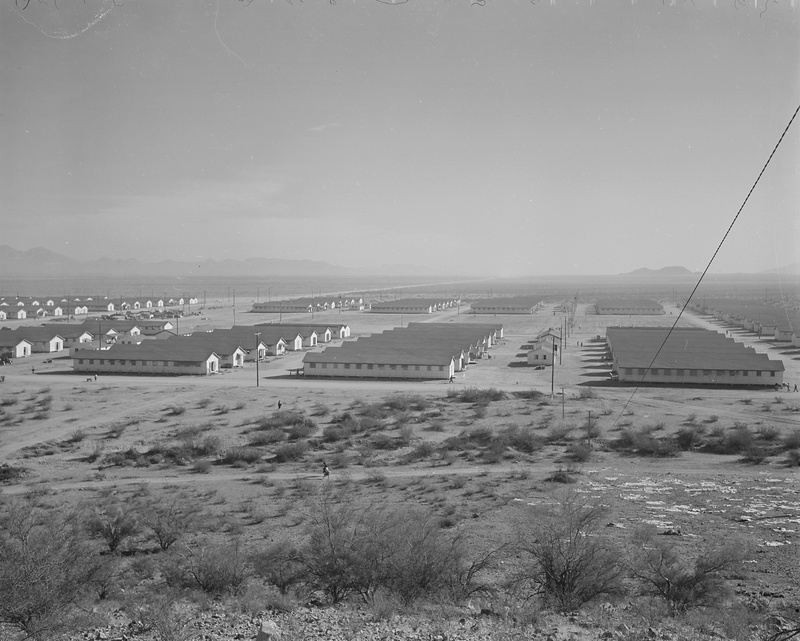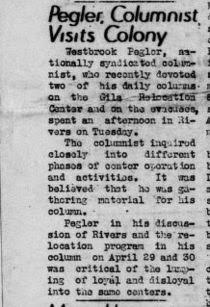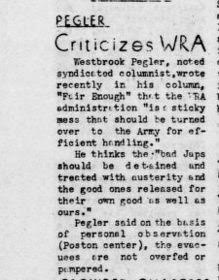On May 4, 1943, a few days after his two columns on Japanese Americans appeared in print (and less than two weeks after Eleanor Roosevelt’s tour of the same camp) Pegler came to Gila River. Afterwards, Pegler wrote in his May 6, 1943 column that conditions were austere and trying, but asserted that many Japanese Americans – specifically Kibei - were disloyal and “savages like the Japanese soldier.” He cited a rumor spread by a nurse at the Gila River hospital that patients had cheered when reports came from Japan that airmen who had been captured after the April 1942 “Doolittle raid” had been executed.
Such persistent and dehumanizing stereotyping won Pegler little appreciation among Japanese Americans. Writing in the Poston Chronicle, Kaz Oka praised Pegler for his “fine, objectively treated articles on the Gila River center” but complained that his rantings about loyal Nisei being mixed in with “brutal and implacable enemies” of the nation formed part of a vicious campaign of hate carried on by the Los Angeles Times. In October 1944, when Pegler left the Scripps-Howard syndicate and began writing for the anti-Japanese Hearst press, the Rohwer Outpost poked fun at the move, commenting that the “vitriol dripping columnist” had gone “from bad to Hearst.”
Over time, though, Pegler’s anti-Japanese rhetoric became less pernicious, or at least was overshadowed by his own greater animus towards the Roosevelt administration. In his June 24, 1943 column “Fair Enough,” Pegler argued that the New Dealers running the camps were treating the vital task of determining the loyalty of the inmates “like a Hyde Park wienie roast.” Pegler asserted that potentially disloyal Japanese Americans should be placed under military guard, while loyal Nisei—whom he equated with those who had never visited Japan—should be released “for their good as well as ours.” Otherwise, he warned, their “loyalty is likely to rot” from unjust confinement. As support for release of Nisei, Pegler cited the case of Hawaii, where local authorities had not encountered any trouble from the 150000 Japanese Americans residing on the islands since Pearl Harbor.
Even if he had cautiously endorsed Japanese American resettlement in his 1943 columns, Pegler must have surprised many readers with the twin columns he wrote in reaction to Korematsu vs. United States. In the first one, dated February 28, 1945, Pegler complained that the Court’s majority had agreed that “it is lawful and correct, in certain circumstances, to imprison in concentration camps native Americans of good reputation who happen to be descendants of immigrants from a country with which we are at war.” In the process, he noted, the court’s decision gave constitutional sanction to racial discrimination, and thereby threatened to block civil rights legislation like New York legislature’s bill against employment discrimination.
Pegler’s second article on Korematsu, in addition to the above-mentioned attacks on Justice Felix Frankfurter, unloaded on Justice Hugo Black, the author of the majority opinion. Pegler denounced Black as a deceitful political hack who had started his career by joining the Ku Klux Klan, “a murderous…gang of night riding racial and religious terrorists,” in order to win votes, and had never ceased violating the civil liberties of Americans. Though his animus against the Roosevelt administration was certainly nothing new, his straightforward attack on General DeWitt, and his defense of civil rights, showed a real development in his thought.
In the postwar years, Pegler continued to write about Japanese Americans and the violation of civil liberties. In an August 28, 1950 column, Pegler reflected on his criticism of the Korematsu ruling in his discussion of the McCarran Internal Security Act of 1950. Although Pegler pointedly stated that the Supreme Court had previously upheld “an act of mass racial persecution,” he did not question the camps as a tool of government repression, and indeed hailed them as a precedent for the government’s potential use of camps against Communists.
Much of Pegler’s postwar career was mired in controversy. In 1948, he led a vicious campaign against former Vice President Henry Wallace’s Progressive Party candidacy for President. Pegler accused Wallace of being unfit for office based on the revelation of the “Guru letters,” a series of mystical letters between Wallace and Russian-born eccentric Nicholas Roerich. He emerged as a full-throated supporter of Senator Joseph McCarthy and called publicly for the execution of all members of the Communist Party. In a well-publicized 1950 letter, President Harry Truman referred to Pegler as “a gutter snipe.”
In 1954, at the height of the McCarthy period, Pegler became embroiled in a libel lawsuit brought by journalist and famed war reporter Quentin Reynolds, whom Pegler had accused in 1949 of being an “absentee war correspondent,” a nudist, and a “Communist traitor.” During cross-examination on trial, in what could be described as Pegler choking on his own venom, he admitted that his columns were inspired by “malice.” The court ended by ruling against Pegler, who was forced to pay $100,000 of the $175,0001 sum in damages to Reynolds (the remainder was paid by the Hearst corporation, Pegler’s employer). The trial inspired a Broadway play, A Case of Libel, which was later adapted into two TV movies.
The libel trial ended Pegler’s relationship with the Hearst Press, and defined his subsequent career. In later years, Pegler turned to radical conservatism. In the 1960s, Pegler became a regular columnist for the John Birch Society, through which he consistently criticized the Civil Rights Movement. Pegler died on June 24, 1969 in Tucson, Arizona.
Although Westbrook Pegler’s writings seem to be part of the distant past, his career forms a disturbing forerunner of the sensationalizing of politics by right-wing media outlets like Fox News. In fact, latter-day pundits such as William F. Buckley and Sarah Palin have pointed to Pegler’s writings as models of communicating populist rhetoric. Pegler provides a textbook example of the contribution of sensational journalism to mass incarceration. Along with Walter Lippmann and others, Pegler reported “fake news” of disloyal Japanese Americans during early 1942. His incendiary language not only inspired West Coast political leaders to advocate mass exclusion, but later constituted part of the government’s argument justifying incarceration.
And yet, Pegler was a more complex figure than his race-baiting image would suggest. From the outset of the war, he wrestled with his competing concerns over national security and personal liberty. Even as he lent credence to false charges of Japanese American subversion, he freely confessed his discomfort with the camps that resulted. At first he refrained from blaming the Roosevelt administration. However, the logic of his position, as well as his venom against FDR and liberal Supreme Court justices, led him gradually into opposition, with his no-holds-barred attack on the Korematsu decision. In the end, despite his anti-Japanese animus, he supported the basic constitutional rights of American citizens, a point that had already troubled him in his previous columns.
© 2021 Greg Robinson; Jonathan van Harmelen












